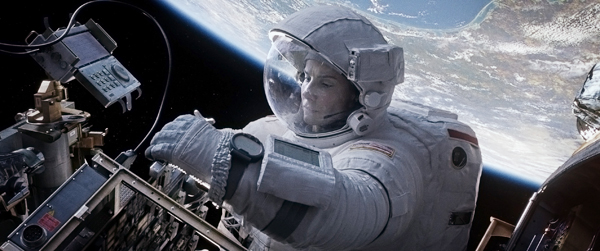CGI-heavy ‘Gravity’ a tale of life, survival

Sandra Bullock plays a bioengineer sent on a mission to fix a satellite when things take a very big turn for the worse. Provided by Warner Bros. Pictures
Since then, the film’s screened at film festivals in Telluride, Colorado, and Toronto and finally hit theaters in the United States, where it set a new record for an opening weekend in October, earning $55 million from Oct. 4 to 6.
Released in Korea yesterday, it seems likely that local viewers will take a shine to the acclaimed hit, if advanced bookings are anything to go by. As of press time, “Gravity” is accounting for 54 percent of all advanced ticket sales.
Critics have rightly drawn similarities to James Cameron’s “Avatar,” in terms of its ubiquitous and groundbreaking special effects.
Visually, it is just as spectacular as James Cameron’s masterpiece, albeit with very different color schemes. Instead of a pastel-fused fantasy world inhabited by feline-like creatures, Cuaron’s world is dark and desolate, with the light coming through the void of space looking strikingly different than light does here on Earth.
The sound, too, or rather, the silence, is deafening. Together, the elements of the film add up to something bigger, creating a movie that is almost too real for comfort.
In orbit around the Earth, some 600 kilometers (372 miles) above the surface, with no sound and no air, human perseverance and vulnerability are put to the test through two of the world’s most beautiful people. But even with the guidance of Sandra Bullock and George Clooney, it’s hard not to feel the isolation of Cuaron’s space.
The film starts off with Ryan Stone (Bullock), a biomedical engineer, and Matt Kowalski (Clooney), a veteran astronaut, on a mission to repair a satellite.
(Apparently the script went to Robert Downey Jr. at first, but it’s hard to imagine anyone being able to pull off Clooney’s goofy-but-confident astronaut.)
Then there’s Stone (Bullock), a rookie when it comes to space. She’s uptight, job-oriented and resistant to Clooney’s charms, all somehow reminiscent of the romantic comedies that she’s been in countless times before. But that’s before the accident strikes.
It seems Murphy’s Law is stronger than the law of gravity, as things take a turn for the worse when the Russians (of course) launch a missile to destroy one of their satellites.
It isn’t long before debris from the Russian explosion slowly but surely ripples out toward the Americans.
For the first half of the movie, Bullock’s damsel-in-distress status, compared to Clooney’s space cowboy, is enough to make any woman cringe.
But it’s not long until Bullock, forced by the necessity of survival, unearths a new persona that just sucks you in.
To be fair, there really isn’t anything distracting in each frame. As the ordinary Bullock deals with each obstacle, it’s hard to turn your eyes away from her clumsy movements.
The film has amassed a 98 percent “freshness” rating on the RottenTomatoes Web site, which is close to a perfect score. Even if outer space is not your thing, the film is worth checking out just to ponder how the filmmaker did what he did with the CGI and animation. Cuaron and the animators said earlier that they had to “relearn physics” in order to make the film.
The result? Even Cameron has called the movie, “The best space film ever done.”
And while The New York Times and a couple of other media outlets have criticized some of the science behind the movie, those issues clearly have not deterred filmgoers.
When you are watching, the images are so compelling that it’s really hard to believe Bullock and Clooney were not in space, or that their heads were digitally stuck into the spacesuits of real astronauts.
Without much dialogue and no flashbacks, the fragility of life and the past trauma that shape a person take center stage.
The film points to a new way of exploring space. Aliens were never the problem after all. It makes you wonder why Hollywood bothered making space movies up until now.
By Carla Sunwoo [carlasunwoo@joongang.co.kr]










with the Korea JoongAng Daily
To write comments, please log in to one of the accounts.
Standards Board Policy (0/250자)